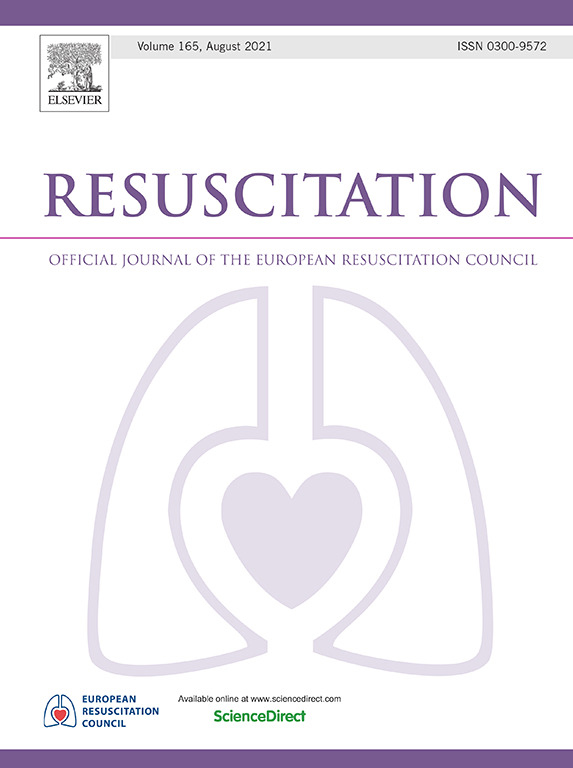心脏骤停后血清神经丝轻链和多模态神经预后——一项回顾性队列研究。
IF 4.6
1区 医学
Q1 CRITICAL CARE MEDICINE
引用次数: 0
摘要
背景和目的:大多数患者在心脏骤停(CA)和复苏后的第一天内仍处于昏迷状态。指南推荐多模式神经预后,包括神经元特异性烯醇化酶(NSE)作为血清生物标志物。神经丝轻链(NFL)可能在心脏骤停后早期具有较高的预后准确性和较低的混杂风险。本研究探讨血清NFL在临床常规中的预后价值,并与已有的预后试验进行比较。方法:对CA后24-96小时血清NFL患者进行单中心回顾性观察研究。出院时通过脑功能分类评分(CPC)评估神经系统预后,分为良好(CPC 1-3)和差(CPC 4-5)。分析了NFL、NSE、脑电图(EEG)、体感诱发电位(SSEP)和头部计算机断层扫描(CT)对神经预后预测好坏的预后表现。采用SIMOA Quanterix法测定NFL。结果:纳入患者152例,中位年龄61岁,女性占24%。出院时植物人或昏迷10例(7%),出院前死亡78例(51%)。NFL >2000pg/ml预测预后不良,敏感性为53%(43-63%),特异性为100%(94-100%)。结论:NFL (SIMOA) >2000pg/ml具有高特异性预测神经预后不良,而低浓度则强烈反对严重的HIE。将NFL添加到已建立的神经预后中可增加不良预后预测的敏感性。本文章由计算机程序翻译,如有差异,请以英文原文为准。
Serum neurofilament light chain and multimodal neuroprognostication after cardiac arrest – A retrospective cohort study
Background and purpose
Most patients remain comatose within the first days after cardiac arrest (CA) and resuscitation. Guidelines recommend multimodal neuroprognostication including neuron specific enolase (NSE) as serum biomarker. Neurofilament light-chain (NFL) may have higher prognostic accuracy earlier after cardiac arrest and a lower risk of confounders. This study investigates the prognostic value of serum NFL in clinical routine compared to established prognostic tests.
Methods
Monocentric retrospective observational study of patients with serum NFL between 24–96 h after CA. Neurological outcome was evaluated at hospital discharge via the Cerebral Performance Category score (CPC), dichotomized as good (CPC 1–3) and poor (CPC 4–5). Prognostic performance for good and poor neurological outcome prediction was analysed for NFL, NSE, electroencephalography (EEG), somatosensory evoked potentials (SSEP), and head computed tomography (CT). NFL was measured using the SIMOA Quanterix assay.
Results
152 patients were included, median age was 61 years, 24% were female. 10 patients were discharged in vegetative state or comatose (7%), and 78 died before discharge (51%). NFL > 2000 pg/ml predicted poor outcome with 53% (43–63%) sensitivity and 100% (94–100%) specificity. Most patients (69%) with NFL < 55 pg/ml had a good outcome. Predictive accuracy was similar to other neuroprognostic tests (AUC 0.89, 0.84–0.94). In head-to-head comparisons with the other neuroprognostic tests, NFL identified 16–41% additional poor outcome patients.
Conclusion
NFL (SIMOA) > 2000 pg/ml predicts poor neurological outcome with high specificity, while low concentrations strongly argue against severe HIE. Adding NFL to established neuroprognostication tests increases sensitivity of poor outcome prediction.
求助全文
通过发布文献求助,成功后即可免费获取论文全文。
去求助
来源期刊

Resuscitation
医学-急救医学
CiteScore
12.00
自引率
18.50%
发文量
556
审稿时长
21 days
期刊介绍:
Resuscitation is a monthly international and interdisciplinary medical journal. The papers published deal with the aetiology, pathophysiology and prevention of cardiac arrest, resuscitation training, clinical resuscitation, and experimental resuscitation research, although papers relating to animal studies will be published only if they are of exceptional interest and related directly to clinical cardiopulmonary resuscitation. Papers relating to trauma are published occasionally but the majority of these concern traumatic cardiac arrest.
 求助内容:
求助内容: 应助结果提醒方式:
应助结果提醒方式:


